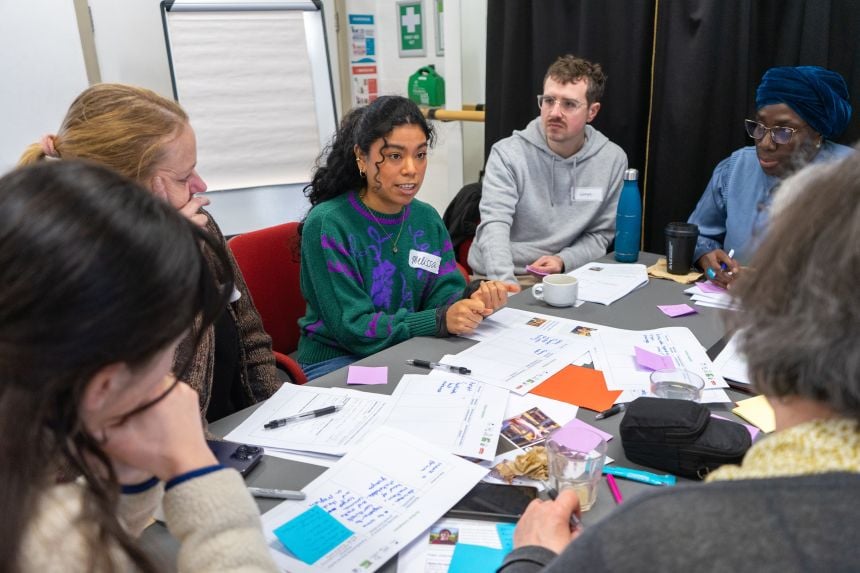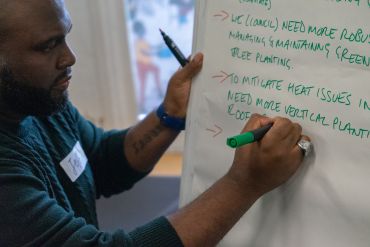Melissa Felipe Cadillo , Programme Coordinator of the Oxford Martin Programme on Biodiversity and Society , describes how universities can act as key brokers to include local residents in decisions on nature recovery in urban environments.
With global biodiversity in a state of crisis, authorities at local, national and international levels have called for ambitious plans for nature recovery. Such policies, however, contend with a range of competing pressures - from job creation and affordable housing, to energy and food production. During the complex decision-making processes to navigate these issues, critical voices are often missing: those of the community members who are directly affected.
 Melissa Felipe Cadillo. Credit: Javiera Pérez Ribalta.
Melissa Felipe Cadillo. Credit: Javiera Pérez Ribalta.Here in Oxford, nature and urban life are closely intertwined, yet there are significant pressures on green spaces from economic growth and demand for housing. Furthermore, Oxford is among one of the most socially unequal cities in the country , and local residents can feel excluded from green areas owned by the universities and colleges. How then can we enable communities to have a more active role in shaping the future of Oxford's natural environment?
One tool to do this is through a Citizens' Jury : a deliberative democracy process that brings together a diverse group of individuals to learn about a societal issue, engage in structured discussions, and collectively develop recommendations. In 2021, the People's Assembly for Nature brought together citizens from Scotland, England, Wales, and Northern Ireland to collectively plan how to tackle the nature crisis, supported by an Independent Advisory Group that included Professor Nathalie Seddon, Director of Oxford University's Nature-based Solutions Initiative . This inspired us to organise the Oxford Citizens' Jury on People & Nature, which aimed to do the same but at the local scale, allowing for a more targeted, place-based focus.
Over four days of deliberative workshops in February 2025, participants of diverse ages, genders, and socio-economic backgrounds engaged with expert evidence, shared personal experiences, and co-created a collective vision for Oxford's environmental future:
"Oxford and its surroundings will be an accessible city for all, with protected green spaces, clean rivers, and rich biodiversity. These will be interconnected through green corridors that nurture the health of both people and nature. To achieve this, we propose enhancing biodiversity and protecting and improving our sustainable built and natural environment, while also reducing division and increasing inclusion among stakeholders. These efforts will be led by diverse and inclusive custodians and supported by strong policies."
Citizens' Juries are not just a means to produce recommendations. They are powerful tools for building capacity, amplifying marginalised voices, and creating shared ownership of urban futures.
Melissa Felipe Cadillo
One of the most surprising findings from the discussions was the strong support for systemic change, particularly the idea of appointing an advocate or representative for nature. Citizens prioritised having this representative present at City Council meetings or planning forums, recognising that this could meaningfully influence decisions. This recommendation stood out across different groups of residents and was frequently mentioned, with broad consensus around its importance.
This idea highlights the need for nature to have a voice in decision-making, especially in urban contexts, and aligns with broader global movements like "Rights of Nature", which argues for legal personhood or formal representation for natural entities like rivers or forests . It also raises a broader question for future participatory processes: Should nature always have some form of representation in democratic or deliberative decision-making spaces (including citizen assemblies)? This is certainly worth exploring further in research and practice.
Through the workshop discussions, the participants co-created eight recommendations on priority actions for the Oxford area. These showed significant overlap with those from the People's Plan for Nature, suggesting a common public concern to balance human needs and nature's well-being. This is particularly interesting since we had actively sought to include participants who are not already engaged in nature or conservation activities.
Recommendations included:
- Provide equitable access to nature For instance, redirect city council funding towards green space accessibility; conduct school visits to raise awareness of nature's value; encourage partnerships between colleges and community groups to open up private green spaces.
- Improve water catchment management For example, improve water quality monitoring and hold agencies accountable; fix water leaks and reduce water wastage; promote greywater reuse for non-drinking purposes.
- Restore rivers and wetlands For instance, convene a community lobby group for waterway protection; integrate biodiversity-friendly drainage solutions into urban drainage systems.
- Integrate nature into the built environment This could include retrofitting urban buildings to include microhabitats; creating and maintaining wildlife corridors; adjusting mowing strategies to benefit wildlife.
 Facilitated discussions during the Citizens' Jury workshops. Credit: Javiera Pérez Ribalta.
Facilitated discussions during the Citizens' Jury workshops. Credit: Javiera Pérez Ribalta.But the Oxford Citizens' Jury demonstrated that these processes are far more than a means to produce recommendations. I was struck by how the discussions promoted bottom-up governance by fostering a sense of belonging, responsibility, and advocacy among residents at neighbourhood, community, and city levels. Many participants commented that they appreciated how the processes created an environment for learning and discussion, which felt open and unbiased. For many, it was the first time they felt heard in local decision-making.
I have lived in Oxford for 20 years, but this is the first time I felt like I had a voice, I had never even heard of a citizens' jury before…
Citizens Jury participant
This clearly shows the potential of deliberative processes to strengthen participatory environmental planning, particularly in urban areas where space, priorities, and access to nature are often contested.
Universities are uniquely placed to facilitate this since they sit at the intersection of formal knowledge and lived experience, allowing them to bridge the gap between communities, researchers, and decision-makers. For the Oxford Citizens' Jury, our next stage will be to promote these recommendations as valid, community-generated evidence that can inform real projects and policies. Besides providing valuable evidence for City and County Councils on what matters to citizens, they can also support grassroots organisations, neighbourhood groups, and parish councils in applying for funding or shaping their initiatives.
 Participants share recommended actions. Credit: Javiera Pérez Ribalta
Participants share recommended actions. Credit: Javiera Pérez RibaltaOur hope is that more City and County Councils will adopt this approach, not only for broad biodiversity or climate planning, but also for specific, place-based projects, such as wetland restoration, river management, and neighbourhood greening initiatives. Ultimately, incorporating lived experience and local knowledge into urban and environmental planning, and nature recovery helps to ensure that decisions reflect what matters most to communities.
Read the full report: Oxford Citizens' Jury on People & Nature - Final Report .
Oxford's Citizens' Jury on People and Nature was led by Melissa Felipe Cadillo and Guillemette Gandon from the Biodiversity & Society Programme and Interdisciplinary Centre for Conservation Science (ICCS) , with facilitation support from Involve Foundation . The project was funded by the Agile Initiative and the Leverhulme Centre for Nature Recovery , with additional support from Nature-based Solutions Initiative (NbSI) .
 Participants and facilitators for the Oxford Citizens' Jury on People & Nature. Credit: Javiera Pérez Ribalta.
Participants and facilitators for the Oxford Citizens' Jury on People & Nature. Credit: Javiera Pérez Ribalta.





